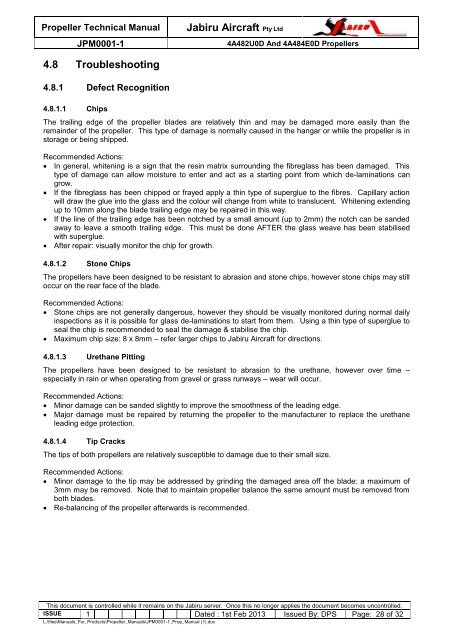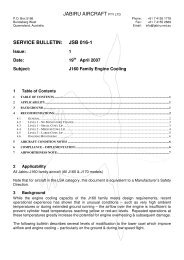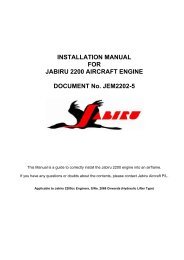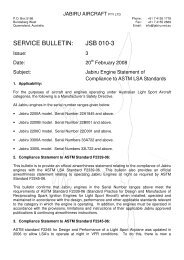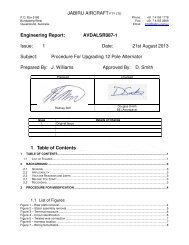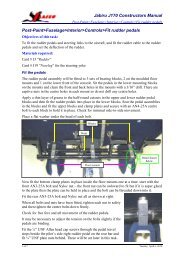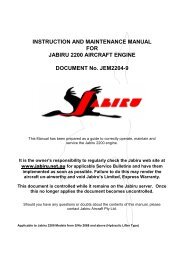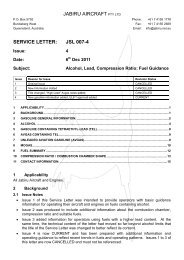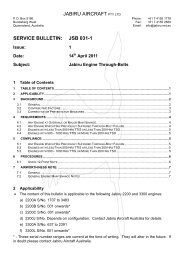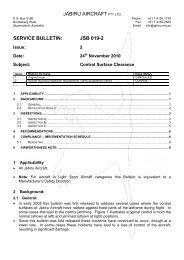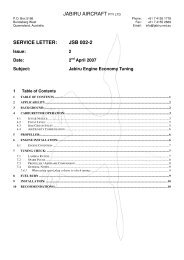Propeller Technical Manual - Jabiru
Propeller Technical Manual - Jabiru
Propeller Technical Manual - Jabiru
You also want an ePaper? Increase the reach of your titles
YUMPU automatically turns print PDFs into web optimized ePapers that Google loves.
<strong>Propeller</strong> <strong>Technical</strong> <strong>Manual</strong><br />
JPM0001-1<br />
<strong>Jabiru</strong> Aircraft Pty Ltd<br />
4A482U0D And 4A484E0D <strong>Propeller</strong>s<br />
4.8 Troubleshooting<br />
4.8.1 Defect Recognition<br />
4.8.1.1 Chips<br />
The trailing edge of the propeller blades are relatively thin and may be damaged more easily than the<br />
remainder of the propeller. This type of damage is normally caused in the hangar or while the propeller is in<br />
storage or being shipped.<br />
Recommended Actions:<br />
In general, whitening is a sign that the resin matrix surrounding the fibreglass has been damaged. This<br />
type of damage can allow moisture to enter and act as a starting point from which de-laminations can<br />
grow.<br />
If the fibreglass has been chipped or frayed apply a thin type of superglue to the fibres. Capillary action<br />
will draw the glue into the glass and the colour will change from white to translucent. Whitening extending<br />
up to 10mm along the blade trailing edge may be repaired in this way.<br />
If the line of the trailing edge has been notched by a small amount (up to 2mm) the notch can be sanded<br />
away to leave a smooth trailing edge. This must be done AFTER the glass weave has been stabilised<br />
with superglue.<br />
After repair: visually monitor the chip for growth.<br />
4.8.1.2 Stone Chips<br />
The propellers have been designed to be resistant to abrasion and stone chips, however stone chips may still<br />
occur on the rear face of the blade.<br />
Recommended Actions:<br />
Stone chips are not generally dangerous, however they should be visually monitored during normal daily<br />
inspections as it is possible for glass de-laminations to start from them. Using a thin type of superglue to<br />
seal the chip is recommended to seal the damage & stabilise the chip.<br />
Maximum chip size: 8 x 8mm – refer larger chips to <strong>Jabiru</strong> Aircraft for directions.<br />
4.8.1.3 Urethane Pitting<br />
The propellers have been designed to be resistant to abrasion to the urethane, however over time –<br />
especially in rain or when operating from gravel or grass runways – wear will occur.<br />
Recommended Actions:<br />
Minor damage can be sanded slightly to improve the smoothness of the leading edge.<br />
Major damage must be repaired by returning the propeller to the manufacturer to replace the urethane<br />
leading edge protection.<br />
4.8.1.4 Tip Cracks<br />
The tips of both propellers are relatively susceptible to damage due to their small size.<br />
Recommended Actions:<br />
Minor damage to the tip may be addressed by grinding the damaged area off the blade: a maximum of<br />
3mm may be removed. Note that to maintain propeller balance the same amount must be removed from<br />
both blades.<br />
Re-balancing of the propeller afterwards is recommended.<br />
This document is controlled while it remains on the <strong>Jabiru</strong> server. Once this no longer applies the document becomes uncontrolled.<br />
ISSUE 1 Dated : 1st Feb 2013 Issued By: DPS Page: 28 of 32<br />
L:\files\<strong>Manual</strong>s_For_Products\<strong>Propeller</strong>_<strong>Manual</strong>s\JPM0001-1_Prop_<strong>Manual</strong> (1).doc


